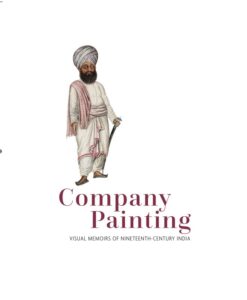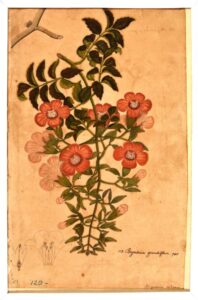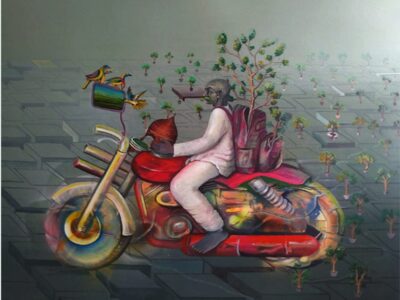National Museum, New Delhi, celebrates the cultural diversity of India with its exhibition of nineteenth-century Company paintings; “Company Painting- Visual Memoirs of Nineteenth-Century India”. The show will remain on view for two months
 Company Paintings in India has been gaining popularity in recent times thanks to the many books that are being written about the huge body of work from the 18th and 19th century. There have been a few exhibitions in recent times that have also contributed to the buzz. The National Museum, National Gallery of of Modern Art, Archaeological Survey of India, New Delhi, and Victoria Memorial Hall and Botanical Survey of India, Kolkata have very rich repositories of company paintings, which by documenting Indian way of life in all its diversity, tradesmen, art and craft, flora and fauna, today, lend themselves to offering fresh perspective and comparative study of history, sociology, and trade. The artists who were primarily hired by the English and other European nationals were from different parts of India, and it is interesting to see how their influences were felt in what can be termed as European style heavily influences by local art.
Company Paintings in India has been gaining popularity in recent times thanks to the many books that are being written about the huge body of work from the 18th and 19th century. There have been a few exhibitions in recent times that have also contributed to the buzz. The National Museum, National Gallery of of Modern Art, Archaeological Survey of India, New Delhi, and Victoria Memorial Hall and Botanical Survey of India, Kolkata have very rich repositories of company paintings, which by documenting Indian way of life in all its diversity, tradesmen, art and craft, flora and fauna, today, lend themselves to offering fresh perspective and comparative study of history, sociology, and trade. The artists who were primarily hired by the English and other European nationals were from different parts of India, and it is interesting to see how their influences were felt in what can be termed as European style heavily influences by local art.
National Museum, New Delhi, celebrates the cultural diversity of India with its exhibition on nineteenth-century painting; “Company Painting- Visual Memoirs of Nineteenth-Century India”. The show will remain on view for two month. For the past couple of years, paintings of this period have drawn significant attention worldwide. Yet, the premium collection of these paintings in Indian museums has largely remained away from public view. The exhibition was envisaged to bring forth a significant collection featuring never seen before paintings from the rich repositories of the National Museum, National Gallery of Modern Art, Archaeological Survey of India, New Delhi, and Victoria Memorial Hall and Botanical Survey of India, Kolkata. This exhibition will give a fresh perspective on various dimensions of Indian life and artistic practices of the time. The exhibition is supplemented with a catalogue that gets together works from various collections, many paintings being brought out for the first time. Particular attention was given to enhance visitors’ experience in the exhibition space with the help of interactive digital interfaces.
“The exhibition is about India and its people, their day-to-day life, rich cultural traditions and the natural surroundings. It is also the story of the resilience of many unknown and known Indian artists who did not give up when the traditional model of patronage and employment collapsed at the dawn of modernity – Dr. Savita Kumari, Assistant Professor, Dept of History of Art, National Museum Institute
More than 200 Company Paintings on Display
 With more than 200 paintings on display, the exhibition touches nearly all genres of the Company Style of painting, from portraits, processions, and ceremonies to diverse indigenous societies, Indian architecture and natural history drawings, and ethnographic studies of Indian life. The exhibition caters to all age groups. As the name “Company Painting” suggests, so far, these paintings have been studied and displayed from the point of view of the patrons, the European colonizers. The approach of this exhibition, however, differs. The curators of the show, Dr. Savita Kumari and Dr. Kanak Lata, challenge the Eurocentric perspective and invites the viewer to engage with the narrative of the depicted. Kumari (who is Assistant Professor in the Department of History of Art, National Museum Institute) is of the opinion, “the exhibition is about India and its people, their day-to-day life, rich cultural traditions and the natural surroundings. The exhibition is also the story of the resilience of many unknown and known Indian artists who did not give up when the traditional model of patronage and employment collapsed at the dawn of modernity. Instead, they adapted to the new situation, modified their technique, and created for themselves a much larger market. Their work equally enchanted their countrymen and the growing European community, particularly the British. These artists showed the path of democratization of art. The ready availability of these paintings in the marketplaces provided the public a chance to possess a charming set of paintings.”
With more than 200 paintings on display, the exhibition touches nearly all genres of the Company Style of painting, from portraits, processions, and ceremonies to diverse indigenous societies, Indian architecture and natural history drawings, and ethnographic studies of Indian life. The exhibition caters to all age groups. As the name “Company Painting” suggests, so far, these paintings have been studied and displayed from the point of view of the patrons, the European colonizers. The approach of this exhibition, however, differs. The curators of the show, Dr. Savita Kumari and Dr. Kanak Lata, challenge the Eurocentric perspective and invites the viewer to engage with the narrative of the depicted. Kumari (who is Assistant Professor in the Department of History of Art, National Museum Institute) is of the opinion, “the exhibition is about India and its people, their day-to-day life, rich cultural traditions and the natural surroundings. The exhibition is also the story of the resilience of many unknown and known Indian artists who did not give up when the traditional model of patronage and employment collapsed at the dawn of modernity. Instead, they adapted to the new situation, modified their technique, and created for themselves a much larger market. Their work equally enchanted their countrymen and the growing European community, particularly the British. These artists showed the path of democratization of art. The ready availability of these paintings in the marketplaces provided the public a chance to possess a charming set of paintings.”
Talking about the Painting Department’s collection of the National Museum, where she serves as the Assistant Curator, Dr. Kanak Lata Singh said, “National Museum has more than sixteenth thousand paintings of different schools, made on different organic materials. I am happy to work for this exhibition and for the publication of these paintings. For discovering these paintings from the collection of the National Museum, especially for this exhibition, the valuables contribution of the staff of the National Museum is worth appreciating.”
 Exhibition is divided into eleven sections
Exhibition is divided into eleven sections
Splendid Indian Maharajas; Indian Aristocrats; Europeans in India; European Print and Indian Painting; Many Paths, One Reality; Indian Deities, Processions, and Ceremonies; Trades and Professions; Vignettes of Everyday Life; Portraitures of Women; Indian Architecture; and Studies of the Natural World.
 The eleven sections are grouped under three broad themes – elite, ethnography, and empirical studies. The first section depicts the elite society of India during the nineteenth century. Significant political changes during this period and the British imperialist designs altered the status quo considerably, giving rise to numerous regional courts and new classes of the middlemen between the East India Company and the native rulers who rose to the status of aristocracy and power. The Company officials and other British residents also formed an important and elite segment of Indian society. These works depict the portraits, processions, and court scenes of Indian royalties from the courts of Tanjore, Awadh, Punjab, and Loharu, among others. Images of Indian aristocrats, East Indian Company officials, and other British residents of India also form a large segment of this group. The second section covers the ethnographic diversity of India. These include works drawn from various sectarian communities found in Hinduism and other religious faiths that prevailed across India. Paintings of flamboyant processions and festivals that celebrated Indian gods and deities and works that offer vibrant glimpses of the professional and daily lives of indigenous Indians from the nineteenth century are also exhibited. These fascinating works form important historical sources that facilitate our understanding of the diversity of regional and ethnic communities of India, also giving a glimpse into their material culture. The third section presents the empirical studies of Indian architecture and natural history. These works were of documentary quality and developed by Indian artists trained in European style and techniques to portray Indian architecture that had culturally diversified and evolved over centuries of history and the rich and vast expanse of Indian flora and fauna life. The section includes significant collections like zoological studies of John Fleming and botanical paintings from the famous ‘Roxburgh Icons.’
The eleven sections are grouped under three broad themes – elite, ethnography, and empirical studies. The first section depicts the elite society of India during the nineteenth century. Significant political changes during this period and the British imperialist designs altered the status quo considerably, giving rise to numerous regional courts and new classes of the middlemen between the East India Company and the native rulers who rose to the status of aristocracy and power. The Company officials and other British residents also formed an important and elite segment of Indian society. These works depict the portraits, processions, and court scenes of Indian royalties from the courts of Tanjore, Awadh, Punjab, and Loharu, among others. Images of Indian aristocrats, East Indian Company officials, and other British residents of India also form a large segment of this group. The second section covers the ethnographic diversity of India. These include works drawn from various sectarian communities found in Hinduism and other religious faiths that prevailed across India. Paintings of flamboyant processions and festivals that celebrated Indian gods and deities and works that offer vibrant glimpses of the professional and daily lives of indigenous Indians from the nineteenth century are also exhibited. These fascinating works form important historical sources that facilitate our understanding of the diversity of regional and ethnic communities of India, also giving a glimpse into their material culture. The third section presents the empirical studies of Indian architecture and natural history. These works were of documentary quality and developed by Indian artists trained in European style and techniques to portray Indian architecture that had culturally diversified and evolved over centuries of history and the rich and vast expanse of Indian flora and fauna life. The section includes significant collections like zoological studies of John Fleming and botanical paintings from the famous ‘Roxburgh Icons.’
The section includes significant collections like zoological studies of John Fleming and botanical paintings from the famous ‘Roxburgh Icons
Overall, the exhibition is a pictorial memoir that will take the viewers on a journey of the culturally vivid and diverse period of nineteenth-century India. It will provide a rare chance to see the works of great masters like Ghulam Ali Khan, Latif, Sheikh Mohammed Ameer of Karayya and Sani, among many other unknown masters. The digital interventions in the exhibition are bound to make a family outing fun.













